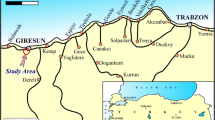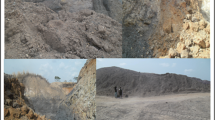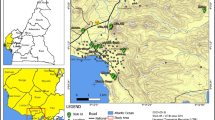Abstract
The objective of this study was to examine the effects on the stability of slope debris of planned slope excavations around the vicinity of Gumushane Imam-Hatip High School in NE Turkey. To assess the geotechnical properties of slope debris along the determined cross-sections, four exploration boreholes with a total length of 100 m were drilled and undisturbed soil samples were collected. Slope debris is composed of two soil zones and its depth varies between 15 m and 21 m. It was determined from the experimental results that the soil class of the upper zone is CL (low plasticity clay) and CH (high plasticity clay) whereas the soil class of the lower zone is SC (clayey sand) and GC (clayey gravel). Peak cohesions of the upper and lower zones were 26.3 kPa and 10.2 kPa, and their peak internal friction angles were 16° and 24°, respectively. Limit equilibrium (LE) analyses for the slopes were evaluated using Slide v5.0 software for the pre-excavation, post-excavation, and supported cases. The results of LE analyses showed the existence of a landslide along the SW direction; the landslide would extend to cover the whole region if the excavation were to be performed without applying engineering measures. Finally, the precautions to be taken were determined and stability analyses for the supported case were evaluated. These analyses showed that the active lateral forces applied by the proposed retaining walls to the cut slope should be 8325 and 3103 kN, respectively.








Similar content being viewed by others
References
Alemdag S, Kaya A, Karadag M, Gurocak Z, Bulut F (2013) Utilization of limit equilibrium method for the stability analysis of debris: an example of the Kalebasi district (Gumushane). Cumhur Earth Sci J 30(2):49–62
Alemdag S, Akgun A, Kaya A, Gokceoglu C (2014) A large and rapid planar failure: causes, mechanism and consequences (Mordut, Gumushane, Turkey). Arabian J Geosci 7(3):1205–1221
Alemdag S, Kaya A, Karadag M, Gurocak Z, Bulut F (2015) Utilization of the limit equilibrium and finite element methods for the stability analysis of the slope debris: an example of the Kalebasi district (NE Turkey). J Afr Earth Sci 106:134–146. doi:10.1016/j.jafrearsci.2015.03.010
ASTM (2005) Standard test methods for liquid limit, plastic limit and plasticity index of soils. In: Annual Book of ASTM Standards, ASTM D4318, Philadelphia, PA
ASTM (2006) Standard practice for classification of soils for engineering purposes (Unified Soil Classification System). In: Annual Book of ASTM Standards, ASTM D2487, Philadelphia, PA
ASTM (2007) Standard test method for particle-size analysis of soils. In: Annual Book of ASTM Standards, ASTM D422, Philadelphia, PA
ASTM (2011) Standard test method for direct shear test of soils under consolidated drained conditions. In: Annual Book of ASTM Standards, ASTM D3080, Philadelphia, PA
Bishop AW (1955) The use of the slip circle in the stability analysis of slopes. Geotechnique 5:7–17
Bishop AW, Morgenstern N (1960) Stability coefficients for earth slopes. Geotechnique 10(4):129–150
Chung CF, Fabbri AG (1999) Probabilistic prediction models for landslide hazard mapping. Photogrammetric Eng Remote Sens 65(12):1388–1399
Dag S, Bulut F, Alemdag S, Kaya A (2011) A general assesment for methods and parameters used in production of landslide susceptibility maps. Gumushane Uni J Sci Technol Inst 2:151–176
Di Maio C, Vassallo R, Vallario M, Pascale S, Sdao F (2010) Structure and kinematics of a landslide in a complex clayey formation of the Italian Southern Apennines. Eng Geol 116:311–322
Dokuz A (2011) A slab detachment and delamination model for the generation of Carboniferous high potassium I-type magmatism in the Eastern Pontides, NE Turkey: the Köse composite pluton. Gondwana Res 19:926–944
Duman TY, Can T, Emre O, Kecer M, Dogan A, Ates S, Durmaz S (2005) Landslide inventory of north western Anatolia, Turkey. Eng Geol 77:99–114
Fell R, Walker BF, Finlay PJ (1996) Estimating the probability of landsliding. In: Proceedings of 7th Australian New Zealand Conference on Geomechanics, Adelaide, Institution of Engineers Australia, Canberra, pp 304–311
Fellenius W (1936) Calculation of the stability of earth dams. In: Proceedings of Transactions of the 2nd Congress on Large Dams, International Commission on Large Dams of the World Power Conference 4:445–462
Ferrari A, Ledesma A, Gonzalez DA, Corominas J (2011) Effects of the foot evolution on the behaviour of slow-moving landslides. Eng Geol 117:217–228
Ferreira MQ (2007) Natural and man-made causes for the Elisio de Moura earth flow in Coimbra, Portugal. Bull Eng Geol Environ 66:35–43
Genc S (1993) Structural and geomorphological aspects of the Catak landslide, NE Turkey. Q J Eng GeolHydrogeol 26(2):99–108
Gokceoglu C, Sonmez H, Nefeslioglu HA, Duman TY, Can T (2005) The March 17, 2005 Kuzulu landslide (Sivas, Turkey) and landslide susceptibility map of its near vicinity. Eng Geol 81(1):65–83
Gu T, Wang J, Fu X, Liu Y (2014) GIS and limit equilibrium in the assessment of regional slope stability and mapping of landslide susceptibility. Bull Eng Geol Environ. doi:10.1007/s10064-014-0689-2
Gurocak Z, Alemdag S, Zaman M (2008) Rock slope stability and excavatability assessment of rocks at the Kapikaya dam site eastern Turkey. Eng Geol 96(1–2):17–27
Guven IH (1993) 1:250000-scaled geology and compilation of the Eastern Pontide. General Directorate of Mineral Research and Exploration (MTA) of Turkey, Ankara (unpublished)
Hungr O, Evans SG, Hazzard J (1999) Magnitude and frequency of rock falls and rock slides along the main transportation corridors of southwest British Columbia. Can Getechnical J 36:224–238
Jaiswal P, Van Westen CJ, Jetten V (2011) Quantitative assessment of landslide hazard along transportation lines using historical records. Landslides 8:279–291. doi:10.1007/s10346-011-0252-1
Janbu N (1954a) Application of composite slip surface for stability analysis. Proc Eur Conf Stab Earth Slopes 3:43–49
Janbu N (1954b) Stability analysis of slopes with dimensionless parameters. In: Harvard Soil Mechanics Series 46, Harvard University Press, Cambridge
Janbu N (1968) Slope stability computations, soil mechanics and foundation engineering report. The Technical University of Norway, Trondheim
Janbu N (1973) Slope stability computations, embankment-dam engineering, vol Casagrande. Wiley, New York
Jeldes I, Vence N, Drumm E (2013) An approximate solution to the Sokolovskiĭ concave slope at limiting equilibrium. Int J Geomech 15(2):04014049. doi:10.1061/(ASCE)GM.1943-5622.0000330
Kahatadeniya KS, Nanakorn P, Neaupane KM (2009) Determination of the critical failure surface for slope stability analysis using ant colony optimization. Eng Geol 108:133–141
Liu F, Zhao J (2013) Limit analysis of slope stability by rigid finite-element method and linear programming considering rotational failure. Int J Geomech 13(6):827–839
Lowe J, Karafiath L (1959) Stability of earth dams upon drawdown. In: Proceedings of 1st PanAmerican Conference on Soil Mechanics and Foundation Engineering 2:537–552
Mantovani F, Gracia FJ, Domenico de Cosmo P, Suma A (2010) A new approach to landslide geomorphological mapping using the open source software in the Olvera area (Cadiz, Spain). Landslides 7:69–74
Morgenstern NR, Price VE (1967) A numerical method for solving the equations of stability of general slip surfaces. Computer J 9(4):388–393
Nefeslioglu HA, Sezer E, Gokceoglu C, Bozkir AS, Duman TY (2010) Assessment of landslide susceptibility by decision trees in the metropolitan area of Istanbul, Turkey. Math Probl Eng 2010:901095. doi:10.1155/2010/901095
Ocakoglu F, Acikalin S, Gokceoglu C, Karabacak V, Cherkinsky A (2009) A multistory gigantic subaerial debris flow in an active fault scarp from NW Anatolia: anatomy, mechanism and timing. Holocene 19(6):955–965
Rocscience (2003) Slide v5.0, 2D limit equilibrium slope stability analysis. Rocscience, Toronto
Sarma SK (1973) Stability analysis of embankments and slopes. Geotechnique 23(3):423–433
Shaorui S, Penglei X, Jimin W, Jihong W, Wengan F, Jin L, Kanungo DP (2013) Strength parameter identification and application of soil-rock mixture for steep-walled talus slopes in southwestern China. Bull Eng Geol Environ 73:123–140. doi:10.1007/s10064-013-0524-1
Spencer E (1967) A method of analysis of the stability of embankments assuming parallel inter-slice forces. Geotechnique 17(1):11–26
Tarcan G, Koca MY (2001) Hydrogeological and geotechnical assessments of the Kadifekale landslide area, Izmir, Turkey. Environ Geol 40(3):289–299
Topuz G, Altherr R, Siebel W, Schwarz WH, Zack T, Hasozbek A, Barth M, Satir M, Sen C (2010) Carboniferous high-potassium I-type granitoid magmatism in the Eastern Pontides: the Gumushane pluton (NE Turkey). Lithos 116:92–110
Tunusluoglu MC, Gokceoglu C, Sonmez H, Nefeslioglu HA (2007) An artificial neural network application to produce debris source areas of Barla, Besparmak, and Kapi Mountains (NW Taurids, Turkey). Nat Hazards Earth Syst Sci 7:557–570
US Army Corps of Engineers (1970) Engineering and design: stability of earth and rock-fill dams. Engineer Manual EM 1110-2-1902, Department of the Army, Corps of Engineers, Office of the Chief of Engineers, Washington DC
Xu J (2011) Debris slope stability analysis using three-dimensional finite element method based on maximum shear stress theory. Environ Earth Sci 64:2215–2222
Zheng H (2012) A three-dimensional rigorous method for stability analysis of landslides. Eng Geol 145:30–40
Acknowledgments
The authors would like to express their sincerest gratitude to the editor and reviewers for their excellent comments. Thanks also to Ideo Interpretership Co. Ltd. for language editing of the text.
Author information
Authors and Affiliations
Corresponding author
Rights and permissions
About this article
Cite this article
Kaya, A., Alemdağ, S., Dağ, S. et al. Stability assessment of high-steep cut slope debris on a landslide (Gumushane, NE Turkey). Bull Eng Geol Environ 75, 89–99 (2016). https://doi.org/10.1007/s10064-015-0753-6
Received:
Accepted:
Published:
Issue Date:
DOI: https://doi.org/10.1007/s10064-015-0753-6




